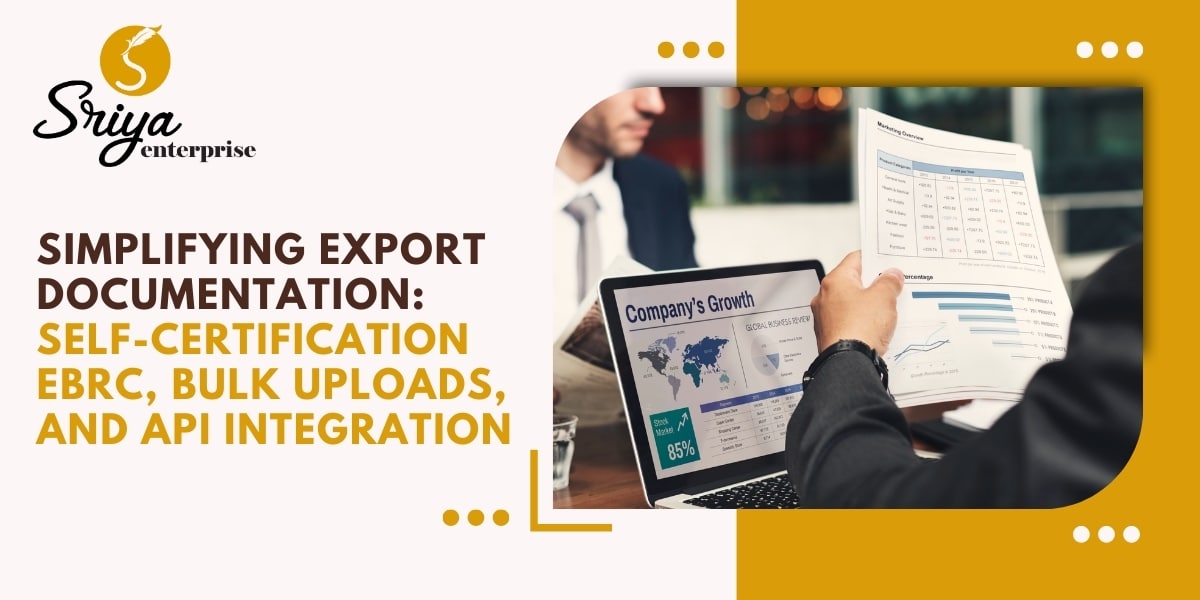Sriya Enterprise recently conducted an insightful Trade Finance and FEMA Workshop at SRF Limited in…

Simplifying Export Documentation: Self-Certification eBRC, Bulk Uploads, and API Integration
In today’s fast-paced global trade environment, exporters need efficient tools to manage documentation and compliance. The Electronic Bank Realization Certificate (eBRC) system, introduced by the Directorate General of Foreign Trade (DGFT), has streamlined the process of confirming export proceeds for Indian exporters. However, recent enhancements like self-certification, bulk upload, and API integration have further simplified the process, making it more user-friendly and efficient.
What is an eBRC?
An eBRC is an electronic certificate issued by banks to exporters in India, confirming the receipt of export proceeds. This digital certificate serves as proof of export realization, which is essential for claiming export incentives and other benefits provided by the government.
The introduction of the eBRC system eliminated the need for physical documentation, making the process quicker and reducing the chances of fraud. However, with evolving business needs, additional features have been introduced to further ease the process for exporters.
Self-Certification in eBRC
The concept of self-certification in the eBRC system allows exporters to certify certain aspects of their export transactions without needing to obtain multiple signatures from various authorities. This reduces the administrative burden on exporters and speeds up the process of document submission.
With self-certification, exporters can now validate and confirm their own export proceeds, provided they meet the conditions set by the DGFT. This move towards self-regulation empowers exporters, especially small and medium enterprises (SMEs), by simplifying compliance.
Recent Updates: Bulk Upload Feature
One of the significant challenges faced by exporters, especially those with large transaction volumes, was the manual entry of each transaction into the eBRC system. Recognizing this, the DGFT introduced the bulk upload feature, allowing exporters to upload multiple transactions at once.
This feature is particularly beneficial for large exporters who handle hundreds or thousands of transactions annually. Instead of entering each transaction individually, exporters can now prepare a CSV or Excel file with all their transactions and upload it to the eBRC portal in one go. This not only saves time but also reduces the chances of data entry errors.
API Integration: Seamless Connectivity
In line with the government’s Digital India initiative, the DGFT has introduced API (Application Programming Interface) integration for the eBRC system. This allows exporters to integrate their internal systems directly with the eBRC platform, enabling seamless data transfer.
API integration is a game-changer for exporters who use ERP (Enterprise Resource Planning) systems to manage their operations. By integrating these systems with the eBRC platform, exporters can automate the process of generating and submitting eBRCs, reducing the need for manual intervention and ensuring data accuracy.
For banks, API integration also facilitates real-time reporting and verification of export transactions, further enhancing the overall efficiency of the eBRC system.
Benefits of These Enhancements
The recent enhancements in the eBRC system—self-certification, bulk upload, and API integration—offer several benefits to exporters:
Time Efficiency: Automation and bulk uploads significantly reduce the time required to generate and submit eBRCs.
Reduced Errors: Automation through API integration and bulk uploads minimizes the chances of human error in data entry.
Cost Savings: By streamlining processes, exporters can reduce the costs associated with manual documentation and compliance.
Enhanced Compliance: Self-certification ensures that exporters remain compliant with minimal administrative hassle.
Scalability: These features are particularly beneficial for large exporters, enabling them to manage high volumes of transactions with ease.
Conclusion
The eBRC system’s recent updates reflect the DGFT’s commitment to facilitating ease of doing business for Indian exporters. By introducing self-certification, bulk upload, and API integration, the government has addressed some of the key pain points faced by exporters, allowing them to focus on their core business activities rather than getting bogged down by documentation.
For exporters, embracing these digital tools is not just a matter of convenience—it’s a strategic move towards staying competitive in an increasingly digital world. As global trade continues to evolve, such initiatives will play a crucial role in ensuring that Indian exporters remain agile, compliant, and ready to seize new opportunities.



